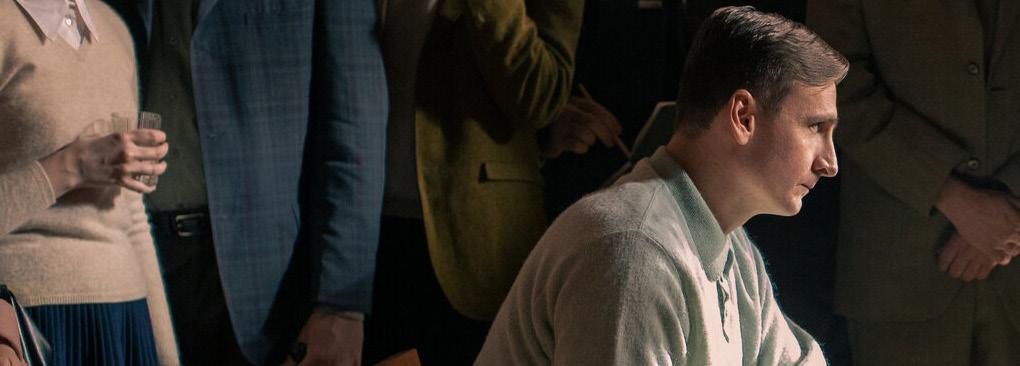
8 minute read
The Queen’s Gambit Review
WRITTEN BY
Lauren Koleszar Doubtful that a show about people playing chess is as captivating as your friends insist? Our review covers not only why they’re right, but the history of the story, an analysis of the plot, and what makes the new Netflix miniseries outshine others.
Advertisement
“T he Queen’s Gambit” tells the story of chess prodigy Elizabeth Harmon, a nine-year-old orphan at the start of the Netflix miniseries, whose talent blossoms during her secret weekly chess matches with the grandfatherly janitor in the basement. Years later, a 15-year-old Beth is adopted by an increasingly dysfunctional married couple, and she seeks opportunities to play chess and submerges herself into the game once again. When she begins competing in matches and earning local and state recognition for her victories, she tells a reporter that she is comforted by the confines of the chessboard. “I feel safe in it,” she says during the interview, “I can control it, I can dominate it. And it’s predictable. So if I get hurt, I only have myself to blame.”
This glimpse into Beth’s character propels us into the conflict that drives the rest of the series forward and deems it highly watchable. As hinted by her reserved and cold nature as a child who is frequently separated from people she cares deeply about, Beth as a young adult remains averse to admitting her vulnerability. As her fame and skill increase dramatically throughout the next few episodes, we see how cold Beth can turn when angered, as well as the way she instinctively pushes people away. While we hope and fear for Beth as she competes against chess champions with the objective of becoming a chess grandmaster, her inner struggle is even more harrowing. It seems that with every personal loss, Beth grows icier and increasingly turns toward stimulants—whether tranquilizing pills, cigarettes or alcohol. As the stakes rise, it becomes frighteningly unclear whether she will become her own worst enemy when she finally has a chance at achieving world acclaim for her chess skills.
Beth Harmon is unlike many protagonists we see onscreen. Styled in a striking ginger bob and impeccable wardrobe with perfect eyeliner, she has absolutely captivated viewers with her gorgeous and intimidating stage presence just as much as her character’s crystalline intellect and human flaws. It’s rare to see introverted characters on-screen and they are usually more popular in novel form. Unsurprisingly, “The Queen’s Gambit” started as a 1983 bildungsroman (check out our last issue for more on this coming-of-age genre) written by Walter Tevis, which explains why Beth has such depth of character. During the transition from book to movie, reserved characters are often brightened up for the screen in an effort to make them more watchable, but the writers for the Netflix adaptation kept Beth as she should be: withdrawn, intellectual, and fiercely vulnerable. Creator Scott Frank’s screenplay keeps Beth true to the novel and actress Anya Taylor-Joy’s performance is captivating and memorable.
Set in 1960s USA and filled to the brim with detail, many viewers have wondered whether “The Queen’s Gambit” is based on a true story. Though the series is completely fictional, the history of the movie rights to the novel “The Queen’s Gambit” is fraught with suspense and tragedy, much like Beth’s own life. Journalists, actors, and directors were desperate for the film rights when the novel was published in 1983. New York Times journalist Jesse Kornbluth obtained the rights that year, but tragedy struck for everyone involved when Tevis died the following year, and the



movie rights were resold. In 1992, the rights were obtained once more but were left untouched until 2007. This film adaptation would have been the late actor Heath Ledger’s directorial debut, starring Ellen Page as Beth Harmon. Yet again, tragedy struck and Ledger’s premature death brought production to a startling halt in 2008. The miniseries we have today was picked up by Netflix in 2019, and “The Queen’s Gambit” starring Taylor-Joy was released on the streaming platform October 23, 2020. We’ll never know what an art house film adaptation of the story would have looked like with Ledger and Page, but writer, director, and executive producer Scott Frank’s Netflix miniseries adaptation has received rave reviews, piloting the show toward rare critical claim, with a 100% rating on Rotten Tomatoes and an 8.8 on IMDb. Writers and filmmakers have been eager for an adaptation of the novel since its publication, and after a long line of unsuccessful attempts, we should be grateful that Beth Harmon’s story has finally been told in a film format for a wide audience to see, cheer for, and enjoy.
There are seven episodes to “The Queen’s Gambit,” making it perfectly bingeable in one weekend. Taylor-Joy’s acting is deserving of award nominations, and the up and coming twenty-four year old actress will no-doubt encounter many more opportunities as a result of this peak performance so early in her career. Familiar faces also include Thomas BrodieSangster, playing the US chess champion and eventual companion of Beth. Also appearing is Marielle Heller, who directed the Fred Rogers’ drama, “A Beautiful Day in the Neighborhood.” In “The Queen’s Gambit”, Heller plays Beth’s adoptive mother, a unique spin on the typical 1950s housewife figure whose alcohol addiction mirrors Beth’s own reliance on stimulants. While she supports Beth’s ride to chess fame, she is by no means the obedient little housewife, but rather a philosophically spoken and complicated woman with selfish human desires.
The characters are strong in “The Queen’s Gambit”— one of the reasons the series is so watchable—but Beth outshines them all. Many female characters in other media are written in an effort to appeal to the modern audience that wishes for greater representation of women and minorities on-screen, but this often ends detrimentally because the strength of the character is lost in the shallow desire for representation. Consequently, we see a plethora of cold, awkwardly masculine female figures on-screen to compensate for the lack of female protagonists in previous years of film and television. Beth Harmon is different. She can be cold, but that is because she is three-dimensional and complicated. She’s contradictory, and that makes her realistic and relatable. She doesn’t care what people think of her and learns to be frank with people this way, but she’s still affected by societal desire to fit in and cares about what clothes she wears and what people say about her. She eventually takes a genuine interest in how she presents herself that is completely independent of the societal pressure of gender norms—that women should look pretty; she dresses up because she loves to dress up. In a fantastically poignant moment in the third episode, Beth and her mother argue about the focus of an article about Beth: “It’s mostly about my being a girl,” says Beth. Her adoptive mother responds, “Well, you are one.” Beth clarifies, “It shouldn’t be that important.” When her mother says, “It makes you a celebrity,” Beth stands her ground, “Yeah, for being a girl.” Clearly, she’d rather the article praise her chess skills and strategy, not what she represents as a female chess champion.
Like every other element of “The Queen’s Gambit,” the plot is strong and compelling; however, critical viewers may notice it does warrant some criticism. Some reviews of the show question whether the consistent support Beth receives despite her cold attitude is realistic or not. Through self-destructive spells in which she cuts off contact from people, the series often suffers from deus ex machina—moments when someone comes to the rescue without much reason besides its usefulness to the plot. People don’t stick around if they’re constantly pushed away or ignored. At
“
“
most, Beth should have two or three people who stand by her side through periods of severe self-destructive behavior. When people start coming to the rescue without any outreach or effort on Beth’s part, Beth’s agency is stripped from her. As a result, her personal growth becomes less self-driven and therefore less meaningful. Interestingly, this phenomenon does not occur in the original novel, which emphasizes Beth’s flaw and treats its consequences very realistically. The novel is much more realistic in the way Beth loses people because of her attitude toward them. Perhaps this was rearranged in the Netflix adaptation to provide a more grandiose and hopeful image, showing how much Beth is missing when she pushes people away. Regardless, this persists as a significant flaw in the series. Though she encounters tragedy, Beth does not face nearly enough consequences for her own actions. Additionally, her flaw is not explored enough in the earlier episodes; we understand that Beth is withdrawn, but she seems to be perfect otherwise for the first half of the series. The writing is excellent and captivating, but not without some noticeable flaws that undermine Beth’s growth as a character.
Those who might find themselves slighted by this should continue watching, however, because the series certainly puts Beth through trials and she must face her past before she says checkmate. Watch “The Queen’s Gambit” this weekend and find yourself delighted by stellar performances, stunning design, and exquisite writing—and surprisingly entertained by watching people play chess, an activity few thought could be so dazzling on-screen.












